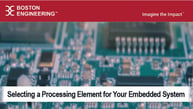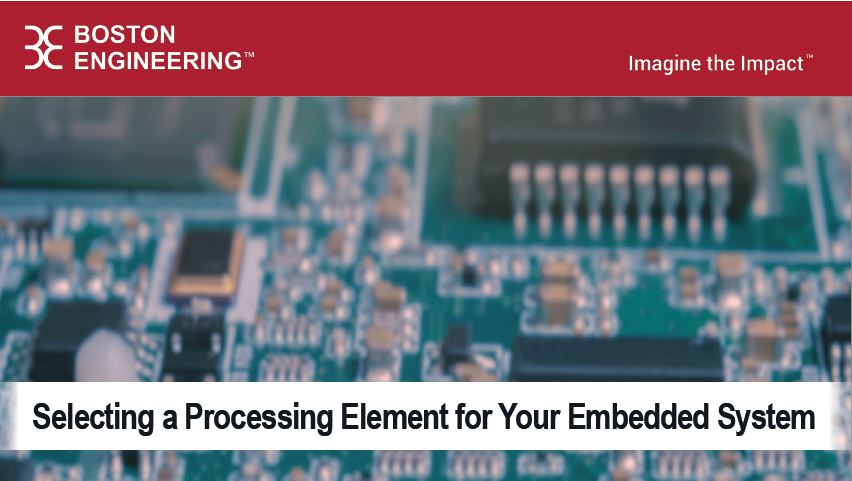Understand the Application, Market, and Requirements when Selecting a Processing Element for Your Embedded System
 This article is an excerpt from the Boston Engineering "Selecting a Processing Element for Your Embedded System" white paper. For a copy of the the complete publication, visit the Selecting a Processing Element for Your Embedded System download page.
This article is an excerpt from the Boston Engineering "Selecting a Processing Element for Your Embedded System" white paper. For a copy of the the complete publication, visit the Selecting a Processing Element for Your Embedded System download page.
1. Understand the Application, Market, and Requirements:
It is often said that successful development starts with good requirements. This is true, but good requirements start with an understanding of the application, what is to be done and why, and the market where this new product or technology is going to be applied. An understanding of the application gives the engineers developing requirements context and a set of goals to base requirements development on. An understanding of the market informs requirements
development by giving the engineering team an understanding of where and how the product is
to be used.
Product portfolio strategies influence requirements and may directly influence process selection. For example, using the same processor family across a product portfolio allows for shared libraries, software and hardware architectures and some design detailing.
Instead of jumping right into requirements for the processing element it is best to start with requirements at the product level and develop them to the point where the requirements for the processing element are clearly visible. We start this process with a block diagram and a list of functions for the product. This is followed by a collaborative team discussion of the block diagram and functions. We are sure to include the customer or client in this discussion.
Embrace the future trends that are shaping a new era of engineering excellence.
Boston Engineering is a multidisciplinary engineering consulting firm that is often faced with the task of selecting a processing element (MCU, MPU, Single board computer, FPGA, SoC, or SoM) for an embedded system. This can be a simple or complicated task based on the project. Fortunately, one can take the same steps to select the processing elements for most embedded systems.
Download for groundbreaking insights!
Once the team established a common understanding of the products and market goals through a review of the block diagram and functions a product requirements document is written. This document is a thorough listing of system functions, capabilities, environment, along with the standards and regulations that the product will meet. It is always a good idea to talk about the timing, main communications channels bandwidths, processing algorithms, response times, dynamic range, and noise floors that you know about at this point.
Once the Product Requirements Document (PRD) is in hand, requirements for the processing element may be developed. Start with a block diagram of the system or printed circuit board the processing element sits in. Work at the architectural level first then add details as the need arise. The exercise of developing an architecture and drawing a block diagram leads to identification of processing element I/O, operating system, peripheral, memory, communications, sensor, ADC, and processing requirements.
With these basic requirements in hand, it is tempting start a trade matrix and drive to a decision. We have found that it is better to include a wider team, if you have not done so already.
For a copy of the the complete publication, visit the Selecting a Processing Element for Your Embedded System download page.
.png?width=760&height=133&name=Surgical%20Robotics%20(1).png)
As the engineering landscape continues to evolve, Boston Engineering is committed to proactively integrating cutting-edge technologies and methodologies into the solutions it delivers, ensuring that clients stay at the forefront of industry trends and maintain a competitive edge.
About the Authors
Aaron Pailes
Sr. Principal Systems Engineer, Boston Engineering
Aaron is a skilled and versatile engineer with a strong background in systems and design engineering. He has contributed significantly to various technological advancements, including side scan sonar platforms, innovative sonar nadir filling technology, security scanners, network monitoring equipment, and RADAR systems
Kathryn Stringer
Electrical Engineer, Boston Engineering
Kathryn designs diverse electrical prototypes for medical/defense sectors, adept in PCB design, testing, and rapid breadboard creation. She collaborates on custom electronics for medical devices and ROV applications.
Tanner Jameson
Electrical Engineer, Boston Engineering
Tanner is a Tufts University graduate, specializing in collaborative circuitry design, software and hardware integration, and product prototyping.
Ready to learn more about Boston Engineering?
For almost three decades, Boston Engineering has designed, developed, and optimized devices and technologies the medical, Commercial, and Defense communities rely on to improve the way people work and live. We provide solutions to the challenges society faces.
Our expertise includes industrial design and product redesign, sensors and control systems, robotics technical innovation, and digital software solutions.
Imagine your Impact: Stay up-to-date with the latest insights and trends we're watching. Add your email address below and sign up for a monthly summary of our most impactful posts!











